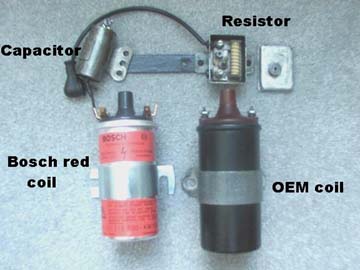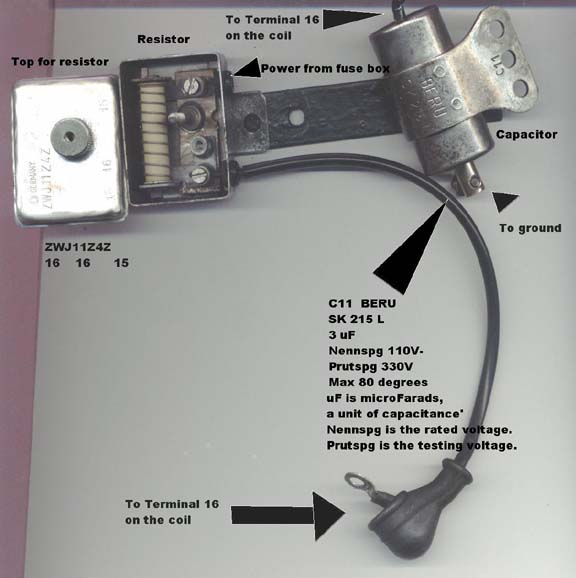
Len Sokoloff / len@sokoloff.com / 1959 220S cabriolet
When it comes time to replace the coil in your Mercedes-Benz Ponton, which replacement coil should you use? I was unsure, so I contacted Randy Durrance who had been working with Mercedes-Benz ignition systems for 25 years. Randy, without hesitation, said I needed the Bosch red coil, which has a Bosch number of 00013 or 0 221 119 030.

He indicated that I should avoid the Bosch blue coil because production for the blue coil has moved to Mexico, and he had experienced some quality control issues with these particular units.
He said that the red coils are now made in Brazil, but they have not suffered any degradation in quality. By the way, the red coil is not really red anymore, but as you can see from the photo, it has a couple of red stickers on it. The output of the red coil is more than twice the output of the standard black coil.

With the Bosch red coil, a resistor of 1.8 ohms should be used if the car is still using points. With an electronic ignition, the resistor is not needed. My Ponton already had a 1.1 ohm resistor in it. After talking with Randy about it, I decided to try the new coil with the resistor I currently have in my car. There typically is some leeway built into the suggested resistance numbers, so my slightly under-rated 1.1 ohm resistor should work sufficiently well. If there is a problem with it, the only thing that will happen is I might go through a set of points a little faster than with the 1.8 ohm resistor. Randy suggested that I continue to run the car at the factory specifications and possibly consider opening up the plug gap just a bit. This might improve the idle quality a bit and increase the response to about 2000 RPM.
If you prefer to use a Bosch coil that is a direct substitute for the OEM coil, the original Bosch number was TK 12 A 10. The original Mercedes-Benz part number was 000 158 07 03. I believe the modern day equivalent Bosch number is 0 221 102 001. With the above information, you should be able to obtain the coil from any Mercedes-Benz dealer or Bosch distributor.
Addendum 1
|
| These coils were indeed introduced from 1950 on. TK 12 A 3 = 0 221 102 001 (introduced in 1950) TK 12 A 9 = 0 221 102 004 (introduced in 1954) TK 12 A 10 = 0 221 102 006 (introduced in ?) Primary resistance of 0 221 102 001 is 3.1-3.6 Ohm. Primary resistance of 0 221 102 004 is 1.8-1.9 Ohm. Must be used with pre-resistor. Primary resistance of 0 221 102 006 is 2.0-2.4 Ohm. Must be used with pre-resistor. Secondary resistances are not provided in our testing documentation. 0 221 102 001 can be replaced by 0 221 119 027. 0 221 102 004 can be replaced by 0 221 119 031 (comes with pre-resistor) or 0 221 119 030 (comes without pre-resistor). 0 221 102 006 can be replaced by 0 221 119 031 (comes with pre-resistor) or 0 221 119 030 (comes without pre-resistor). Mit freundlichen Grüßen / Best regards Matthias Thiess Automotive Aftermarket, Bosch Classic Product Marketing (AA-TR/ATR1) Robert Bosch GmbH | Postfach 41 09 60 | 76225 Karlsruhe | GERMANY | www.bosch.com | www.bosch-classic.com Tel. +49(721)942-1660 | Fax +49(711)811507-1660 | classic@bosch.com |
Addendum 2
|
| The coil ending in the -027 number is today's "blue coil." Thus it is
today's successor to the original TK 12 A 3 fitted to the four-cylinder
gasoline. It has internal resistance, so no ballast external resistor is
needed. The coil ending in the -030 number is today's "red coil" without inclusion of an external ballast resistor in the sales package. Thus it is today's successor to the original TK 10 A 9 originally fitted to the 220SE. One can use the original 1.6-ohm ballast resistor, if still operational (measure its resistance), with this coil. Note: the original resistor can measure as low as 1.1 ohms and still serve the purpose with a new "red coil." The original resistors may not have been all that precise. The coil ending in the -031 number is identical to the -030 "red coil," except that the -031 number includes in the sales package a new external ballast resistor of 1.8 ohms. There will be a different Bosch 5-digit stock number along with the different 10-digit Bosch part number. I recognize that Len Sokoloff's article comes to the conclusion that the "red coil," not the "blue coil," is today the appropriate coil for the four-cylinder Pontons, and thus differs from the information Bosch provides. I do not try to evaluate the difference. Four-cylinder "pontonistas" must make a considered choice. Douglas P. Broome douglas.broome@verizon.net April 23, 2017 |